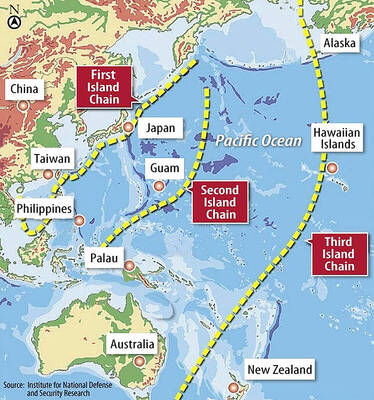The US Department of State has approved the sale of kamikaze drones and missiles to Taiwan for US$360 million, the US Defense Security Cooperation Agency said on Tuesday.
Included in the two separate packages are 720 Switchblade 300 loitering munitions and related equipment for an estimated cost of US$60.2 million, and 291 ALTIUS 600M-V drone systems and related equipment for an estimated cost of US$300 million, the agency said.
“The proposed sale will help improve the security of the recipient and assist in maintaining political stability, military balance and economic progress in the region,” it said in separate news releases announcing the sales.

Photo: Screen grab from AeroVironment’s Facebook page
Taipei had expressed interest in obtaining AeroVironment Switchblade loitering munitions or other devices with similar capabilities to enhance its asymmetric warfare capabilities, sources said last month.
Loitering munitions fly around an area until a target is located, then attack by crashing into it.
The Switchblade 300 is a tube-launched drone designed to attack ground troops, which Ukrainian forces have utilized extensively in their fight against Russia’s invasion.
The ALTIUS 600M-V is the warhead variant of the Anduril series of loitering munitions. It can be deployed from various platforms and in a networked swarm.
The Ministry of National Defense on X yesterday thanked Washington for the approval, saying it would “enhance our ability to meet current and future threats” in accordance with the Taiwan Relations Act and the “six assurances.”
In a separate statement, the ministry said that approval time was significantly expedited for the sales.
It thanked its US counterparts for their efforts to accelerate arms sales to Taiwan.
The US’ official approval of the sale of the weapons would bolster Taiwan’s self-defense capabilities, Presidential Office spokeswoman Kuo Ya-hui (郭雅慧) said.
The Presidential Office thanks the US government for observing the Taiwan Relations Act and the “six assurances,” and continuing to strengthen the Taiwan-US partnership to jointly uphold regional peace, Kuo said.
The combined package is the 15th authorized to Taiwan since the administration of US President Joe Biden took office in 2021, highlighting the US government’s emphasis on regional stability and peace, she said.
Taiwan would continue to augment its self-defense and asymmetrical warfare capabilities to defend and uphold its democratic and free government, she said.
Taiwan would also continue to work with like-minded countries to ensure that the Indo-Pacific region remains free and open to all, foster global peace, stability and prosperity, and contribute in a meaningful and benign manner, she added.
The Ministry of Foreign Affairs said that the US is working with like-minded partners to urge China to stop oppressing Taiwan, and undermining peace and stability in the Taiwan Strait.
Taiwan would continue to deepen Taiwan-US security partnerships, and work together to maintain a rules-based world order to foster stability, peace and prosperity in the Taiwan Strait and the Indo-Pacific region, the ministry said.

LIMITS: While China increases military pressure on Taiwan and expands its use of cognitive warfare, it is unwilling to target tech supply chains, the report said US and Taiwan military officials have warned that the Chinese People’s Liberation Army (PLA) could implement a blockade within “a matter of hours” and need only “minimal conversion time” prior to an attack on Taiwan, a report released on Tuesday by the US Senate’s China Economic and Security Review Commission said. “While there is no indication that China is planning an imminent attack, the United States and its allies and partners can no longer assume that a Taiwan contingency is a distant possibility for which they would have ample time to prepare,” it said. The commission made the comments in its annual

DETERMINATION: Beijing’s actions toward Tokyo have drawn international attention, but would likely bolster regional coordination and defense networks, the report said Japanese Prime Minister Sanae Takaichi’s administration is likely to prioritize security reforms and deterrence in the face of recent “hybrid” threats from China, the National Security Bureau (NSB) said. The bureau made the assessment in a written report to the Legislative Yuan ahead of an oral report and questions-and-answers session at the legislature’s Foreign Affairs and National Defense Committee tomorrow. The key points of Japan’s security reforms would be to reinforce security cooperation with the US, including enhancing defense deployment in the first island chain, pushing forward the integrated command and operations of the Japan Self-Defense Forces and US Forces Japan, as

IN THE NATIONAL INTEREST: Deputy Minister of Foreign Affairs Francois Wu said the strengthening of military facilities would help to maintain security in the Taiwan Strait Japanese Minister of Defense Shinjiro Koizumi, visiting a military base close to Taiwan, said plans to deploy missiles to the post would move forward as tensions smolder between Tokyo and Beijing. “The deployment can help lower the chance of an armed attack on our country,” Koizumi told reporters on Sunday as he wrapped up his first trip to the base on the southern Japanese island of Yonaguni. “The view that it will heighten regional tensions is not accurate.” Former Japanese minister of defense Gen Nakatani in January said that Tokyo wanted to base Type 03 Chu-SAM missiles on Yonaguni, but little progress

NO CHANGES: A Japanese spokesperson said that Tokyo remains consistent and open for dialogue, while Beijing has canceled diplomatic engagements A Japanese official blasted China’s claims that Japanese Prime Minister Sanae Takaichi has altered Japan’s position on a Taiwan crisis as “entirely baseless,” calling for more dialogue to stop ties between Asia’s top economies from spiraling. China vowed to take resolute self-defense against Japan if it “dared to intervene militarily in the Taiwan Strait” in a letter delivered Friday to the UN. “I’m aware of this letter,” said Maki Kobayashi, a senior Japanese government spokeswoman. “The claim our country has altered its position is entirely baseless,” she said on the sidelines of the G20 summit in Johannesburg on Saturday. The Chinese Ministry